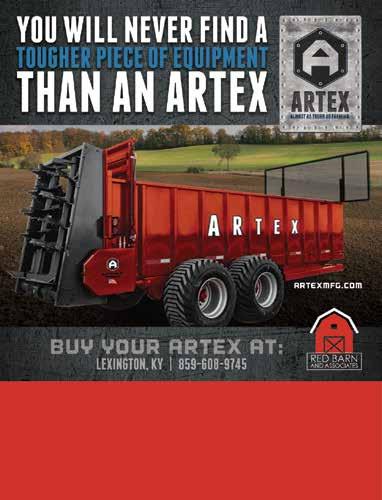
11 minute read
Dr. Katie VanValin: After the Storm: Considerations for Managing Cattle In the Aftermath of Severe Weather
After the Storm: Considerations for Managing Cattle In the Aftermath of Severe Weather
Dr. Katie VanValin Extension Professor, University of Kentucky
December is one of the busiest times for many of us. It’s breeding season for fall calving herds, and many are starting winter feeding programs. In addition to everyday farm life, December also brings the hustle and bustle of the holiday season. However, this year for many people throughout western Kentucky and beyond, December brought unimaginable destruction and devastation in the form of a devastating tornado outbreak on December 10th and 11th, 2021. The University of Kentucky Research and Education Center in Princeton, KY, suffered catastrophic damages from an EF-4 tornado on the evening of December 10th. Although the destruction the tornado left behind is devastating, the University of Kentucky community is fortunate that there was no loss of life amongst our colleagues, and the injuries were minor. Unfortunately, the beef herd at the UKREC lost cattle in the storm and in the days that followed. However, when standing in the rubble of our buildings or in our debrisridden pastures, I often think that it is truly a miracle that our people and our cattle were not more severely impacted by the storm. There is no doubt that severe weather can cause significant disruptions to cattle operations. While some of the impacts are noticeable and will be felt immediately, others may not be so obvious and maybe felt for many years to come. Human Life. In the immediate aftermath of severe weather, priority should be placed on ensuring that everyone is accounted for and safe. Once family members, friends, and neighbors are accounted for, and severe weather is no longer a threat, it is time to focus on agricultural damages and losses. Securing Animals. Every effort should be made to safely secure livestock in areas where fencing may have been impacted. Cattle getting out onto roadways can cause a secondary emergency. Securing cattle may involve: • Moving them to a location where
perimeter fencing has less damage. • Combining multiple groups of cattle into one area. • Installing temporary fencing. • Making repairs to damaged fences. Electricity may be out; solar-powered fence chargers are especially useful when installing temporary fences. When securing animals on a stormdamaged operation, evaluating feed and water resources is also essential. It is possible that even if your operation only sustained minor damages, that impacts to surrounding areas could impact municipalities. It may be necessary to haul water to cattle. The storm may have affected feed resources, including hay, grain, and feeding equipment. People in the agricultural community are quick to jump in and help, so taking a few moments to determine your needs will allow others to assist you more efficiently. At the UKREC, we lost water and needed to have water trucked in for several days. Thankfully, local farmers and the fire department were more than happy to help us haul water to our cattle in the days following the storm. To account for cattle and determine if any may be missing, it is helpful to have an upto-date list of animal numbers and pasture locations. As animals may be in larger groups and possibly confined to smaller areas, it can be difficult to accurately count cattle; especially calves. Have an individual animal I.D. system and an accurate list of tag numbers so numbers can be checked off as cattle are accounted for. Animal injuries. Cattle will likely suffer injuries during violent storms, including lacerations and broken bones. When possible, work with a veterinarian to evaluate the injuries sustained during the storm and develop treatment protocols for those animals that can be treated or humanely euthanize severely injured animals. One thing that should be considered during this time is your ability to treat and care for injured animals. Cattle handling facilities and barns may have also been damaged in the storm, making the safe treatment of some injuries difficult or impossible. The goal here is to do no harm. There may be injuries that could otherwise be treated in a typical scenario that may require euthanasia in a disaster scenario. Again, when possible, work with a veterinarian to evaluate cattle on the operation. Animal death. Unfortunately, some cattle die from injuries sustained during weather events. While the hope is that this number is low, the herd mentality of cattle means they often congregate together, leading to the devastating loss of life during natural disasters. Be sure to keep an accurate count of animals that are lost during the storms. The United States Department of Agriculture’s livestock indemnity program will help financially compensate producers that lose livestock. Other programs may also be available to help, so contact your local extension office, USDA-FSA office, and emergency management office. Ensure you know the programs available to you and the documentation and deadlines associated with these programs. Proper carcass disposal is also critical. Again, every effort must be made to not create secondary issues during the aftermath of a weather emergency. In Kentucky, acceptable methods of animal disposal include burial and composting. If you are unsure of how to or cannot properly dispose of animals on your operation, reach out to your local county extension office or emergency management offices for assistance. Hardware disease. Hardware disease occurs when ruminants consume metal debris, including screws, nails, and metal wire. This debris becomes logged in the reticulum, the first compartment in a ruminant animal’s stomach. These metal fragments can cause damage to or puncture the wall of the reticulum, diaphragm, or the pericardium (protective sac around the heart). Hardware disease can be challenging to diagnose because its symptoms, including depression, poor appetite, and reluctance to move, can often
One of the barns collapsed at the UKREC beef unit, other barns, silos, handling facilities and fences also sustained damage in the storm.
mimic other conditions. Placing a magnet in the reticulum can help attract metal debris away from the walls of the reticulum, which can treat or prevent hardware disease. Every effort should be made to prevent the ingestion of metal objects by carefully clearing affected pastures of storm debris. The use of commercial-grade magnets can help clear pastures. Additionally, metal detectors can be used to identify metal debris. However, these tools will not detect or collect all potentially harmful debris in pastures. It is also important to ensure that feeds such as hay or grains were not contaminated with metal debris that cattle could ingest. Reproductive complications. Stress has a negative impact on reproductive outcomes, and undoubtedly severe weather events cause stress on livestock. Stress can significantly decrease conception rates of cattle. Although, we would typically expect tornadic activity to impact the breeding season of spring calving herds, this outbreak happened to occur during the breeding season for fall calving herds. At the UKREC, we utilize A.I., and the entire herd happened to be bred the morning of December 10th. We expect conception rates to A.I. to be extremely low, especially in the animals most affected by the tornado. Additionally, cattle may also abort due to the stress of weather events. Pregnancy is a luxury; it is not necessary for survival. Thus, when cows experience stress, such as extreme weather events, biological processes kick in to help them survive (think fight or flight response). These processes affect every part of the body with the end goal of helping the cow survive. Thus, luxury processes such as pregnancy or even lactation can be negatively affected by stress. Keep a close eye on nursing calves in the days and weeks following storms, especially those whose dam may have been injured or killed due to the storms. These reproductive complications will likely go unnoticed at first but can have devastating impacts on the herd’s future. Work with your county extension agent and local veterinarians to help assess the potential reproductive impacts on the cow herd. The impact of these tornadoes will be felt for many years to come in the impacted regions. If you or someone you know has been affected by the storms, continue to seek assistance as the recovery process is long and challenging. These storms were so powerful and brought so much destruction in just a matter of seconds. Still, the strength, resilience, kindness, and generosity of friends, neighbors, colleagues, and complete strangers from all over the United States has been stronger. The debris will be cleaned up in time, and the physical structures that make up the University of Kentucky Research and Education Center will be rebuilt. In the meantime, the people of the University of Kentucky Research and Education Center will strive to continue our work serving the agricultural community of Kentucky and beyond.
Spring Calving Herds
• Have calving equipment, supplies and labor ready for the spring calving season. Some supplies which may be needed are: eartags and applicator (put numbers on eartags now), tattoo pliers and ink, record book, scales for calf weights, iodine for calves' navels and colostrum supplement. Calving equipment (puller and chains, etc.) and facilities should be ready and clean. Keep your veterinarians phone number handy! • Overall condition of the cow herd should be evaluated. Cows losing weight now are more likely to have weak or dead calves. These cows will likely be a poor source of colostrum milk for the newborn calf.
Feed cows, if necessary to keep them in good body condition. Cows need to calve in a BCS of 5, minimum, to expect them to rebreed in a timely fashion. Calve you heifers a little heavier, BCS of 6. • Heifers may begin head-start calving in early February. Move them to a clean, accessible pasture, away from cow herd and near facilities so that calving assistance can be given. Cows may start calving later this month. Signs of calving are relaxation of pelvic ligaments, enlargement and swelling of the vulva, and enlargement of the udder. Expect calving difficulty if (1) calf's head and two feet are not visible, (2) only the calf's tail is visible, and (3) the cow has been in labor for 11⁄2 hours. Be sure calf is being presented normally before using calf puller. Recognize situations that are beyond your capability and seek professional help as early as possible. Calves that aren’t breathing should receive assistance. Try sticking a straw in nostril to stimulate a reflex or try alternate pressure and release on rib cage.
Commercial respirators are also available. Calves should consume colostrum within 30 minutes of birth to achieve good immunity. • Record birthdate, cow I.D., and birthweight immediately (use your
Beef IRM calendar). Identify calf with eartag and/or tattoo. Registered calves should be weighed in the first 24 hours. Male calves in commercial herds should be castrated and implanted as soon as possible. • Separate cows that calve away from dry cows and increase their feed. Increase feed after calving to 25-27 pounds of high quality hay.
Concentrate (3-4 lb. for mature cows and about 8 lb. for first-calf heifers) may be needed if you are feeding lower quality hay. Supplementation may have a beneficial effect on date and rate of conception. It’s important time to feed a beef cow after calving. Thin cows don't come into heat very soon after calving. We must have cows in good condition, if we plan to breed them early in the season for best pregnancy rates, especially on high-endophyte fescue pastures. • Sub-zero weather can mean death for newborn calves. During extremely cold spells, bring the cow(s) into a sheltered area as calving approaches to protect the calf. Be prepared to warm-up and feed newborn, chilled calves. Calving in mud can also cause problems. • Watch for scours in newborn calves. Consult your veterinarian for diagnosis, cause, and treatment. Avoid muddy feeding areas so that cows' udders won't become contaminated and spread scours. Don't confine cows to muddy lots. • Replacement heifers should be gaining adequately to reach target breeding weights by April 1st. Be sure that their feeding program is adequate for early breeding. • Start looking for herd sire replacements, if needed.
Fall-Calving Herds
• Breeding season should end this month – maybe Valentine’s Day.
Remove bulls and confine them so that they regain condition. • Consider creep feed or creep grazing (wheat, etc.) to supply extra nutrition to fall-born calves which may have to depend solely on their dam’s milk supply for growth. They are not getting much except their dam’s milk now (i.e. there is nothing to graze). February/March is the worst time of the year for fall-born calves. • Provide windbreaks or clean shelter for calves.


General Reminders
• Increase feed as temperature drops. When temperature falls below 15 degrees, cattle need access to windbreaks. For each 10 degree drop below 15 degrees, add three pounds of hay, two pounds of corn, or six pounds of silage to their rations. • Provide water at all times. Watch for frozen pond hazards. If cattle are watering in a pond, be sure to keep ice “chopped” to keep cattle from walking on the ice and, possibly, breaking through. Keep automatic waterers working. • You should be feeding a mineral supplement with adequate magnesium to prevent grass tetany (~ 15% Mg) now. The Hi-mag UK Beef
IRM mineral can be used now. • Control lice. Watch for signs such as rubbing. • Begin pasture renovation. You can overseed clover on frozen or snow-covered pastures.

Come see us at the Farm Machinery Show
Artex - Booth 2987 • Red Barn – Booth 3347
Also offering the following: Farmco- cattle feeding • Lancaster Partshammermills • Horning - rotary corn headers • Esch high speed no till drill Cloverdale TMR MIXERS • Stoltzfus LIME SPREADERS Val6-Val6- shopshop commercialcommercial heatersheaters













